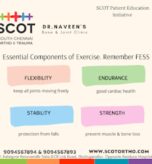RICE in Orthopaedics
What is RICE?
RICE is a mnemonic that stands for Rest, Ice, Compression, and Elevation. It is a simple and effective treatment for minor musculoskeletal injuries, such as sprains, strains, and bruises. RICE can help to reduce pain and swelling, and promote healing.
When to use RICE
RICE can be used for minor musculoskeletal injuries, such as:
- Ankle sprains
- Knee sprains
- Shoulder sprains
- Muscle strains
- Tendonitis
- Bruises
How to use RICE
Rest:
- Stop the activity that caused the injury.
- Avoid putting weight on the injured area.
- Use crutches or a cane to help you walk, if necessary.
Ice:
- Apply ice to the injured area for 20 minutes at a time, several times a day.
- Wrap the ice pack in a towel to protect your skin.
- Do not apply ice directly to your skin.
Compression:
- Wrap the injured area with an elastic bandage or compression sleeve.
- Be careful not to wrap the bandage too tightly, as this can restrict blood flow.
Elevation:
- Raise the injured area above the level of your heart.
- This will help to reduce swelling.
How long to use RICE
RICE should be used for the first 24-48 hours after an injury. After that, you can start to gradually return to your normal activities. However, it is important to continue to rest the injured area and avoid activities that cause pain.
Variations of RICE
There are a few variations of the RICE method, such as:
- PRICE: This acronym stands for Protection, Rest, Ice, Compression, and Elevation. Protection is added to emphasize the importance of preventing further injury to the affected area.
- POLICE: This acronym stands for Protection, Optimal Loading, Ice, Compression, and Elevation. Optimal Loading refers to the process of gradually increasing the amount of weight and activity that the injured area can tolerate.
- RICER: This acronym stands for Rest, Ice, Compression, Elevation, and Referral. Referral is added to emphasize the importance of seeking medical attention if the injury is severe or does not improve after a few days of RICE treatment.
When to see a doctor
You should see a doctor if:
- The injury is severe.
- The pain is severe or does not improve after a few days of RICE treatment.
- There is significant swelling.
- You cannot move the injured area.
- You have numbness or tingling in the injured area.
- You have a fever.
Conclusion
RICE is a simple and effective treatment for minor musculoskeletal injuries. It can help to reduce pain and swelling, and promote healing. However, it is important to seek medical attention if the injury is severe or does not improve after a few days of RICE treatment.
SCOT: Dr.Naveen’s Bone and Joint Clinic, Sholinganallur
9094567894 , 9094567893





